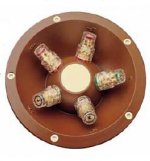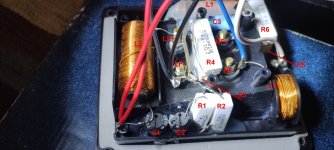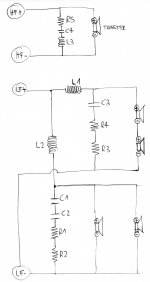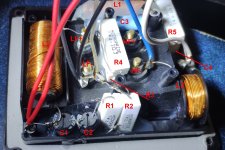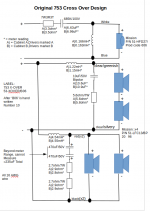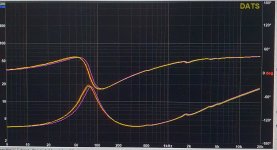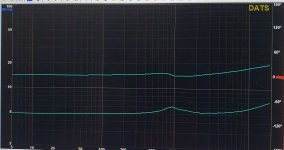Today my new inductance meter arrived...
So I can fill in now the rest of the crossover values.

The crossovers are from the tweeter down.
An airwound coil, with the guage being bout 0.7mm diameter in the tweeter
A Ferrite core coil with similar guage on the mid.
A pair of ferrite coils on the woofer, the 2.45 being of a higher guage aprox 0.8mm and the 2.4mh being slightly smaller (as fas as I can tell) approx 0.7mm
I could spend a fortune on inductors here, though I am more inclined to roll my own. Can anyone give me some advice please on what would be sensible. I am aiming for air core, possibly 1.3 - 1.6mm perhaps higher if there are gains to be had.
Does it make sense to use different guages on each crossover?
I want a good quality vs cost solution.
I measured the capacitance on the 10mfd cap, it measures 10.3ufd. So the capacitance has either increased or was higher to begin with and has not changed. Can anyone make a reasoned gues as to which is which?
Also can someone tell me the types of filters I am dealing with so that I can find calculators for them?
Comments please. I'm learning slower than my ambitions dictate.
Blair
So I can fill in now the rest of the crossover values.

The crossovers are from the tweeter down.
An airwound coil, with the guage being bout 0.7mm diameter in the tweeter
A Ferrite core coil with similar guage on the mid.
A pair of ferrite coils on the woofer, the 2.45 being of a higher guage aprox 0.8mm and the 2.4mh being slightly smaller (as fas as I can tell) approx 0.7mm
I could spend a fortune on inductors here, though I am more inclined to roll my own. Can anyone give me some advice please on what would be sensible. I am aiming for air core, possibly 1.3 - 1.6mm perhaps higher if there are gains to be had.
Does it make sense to use different guages on each crossover?
I want a good quality vs cost solution.
I measured the capacitance on the 10mfd cap, it measures 10.3ufd. So the capacitance has either increased or was higher to begin with and has not changed. Can anyone make a reasoned gues as to which is which?
Also can someone tell me the types of filters I am dealing with so that I can find calculators for them?
Comments please. I'm learning slower than my ambitions dictate.
Blair
Hi,
I'd go for aircore on the mid and leave it at that, bypass mid electrolytic.
Low DCR on the bass units doesn't make much sense with a 2.2R
series resistor.
The type of filters you are dealing with (real ones) are to produce
a resultant acoustic response of the speaker, there is no such
thing as a generic calculator for them.
see here :
http://www.rjbaudio.com/Audiofiles/FRDtools.html
🙂/sreten.
I'd go for aircore on the mid and leave it at that, bypass mid electrolytic.
Low DCR on the bass units doesn't make much sense with a 2.2R
series resistor.
The type of filters you are dealing with (real ones) are to produce
a resultant acoustic response of the speaker, there is no such
thing as a generic calculator for them.
see here :
http://www.rjbaudio.com/Audiofiles/FRDtools.html
🙂/sreten.
sreten said:Hi,
I'd go for aircore on the mid and leave it at that, bypass mid electrolytic.
Low DCR on the bass units doesn't make much sense with a 2.2R
series resistor.
The type of filters you are dealing with (real ones) are to produce
a resultant acoustic response of the speaker, there is no such
thing as a generic calculator for them.
see here :
http://www.rjbaudio.com/Audiofiles/FRDtools.html
🙂/sreten.
Thanks for the input sreten. As always a couple more questions...
My reasoning behind going aircore on the bass drivers is that I have read the solid cores cause distortion. I was looking to remove this as much as possible. Is it a rule of diminshing returns on the woofer crossover?
You mention bypassing the lytic on the mid, I take it you mean with a small polyproblene cap? I had planned to try this.
Thanks for the answer on the filters, I have looked everywhere for calculators... i can give up now and move onto something else.
Anyone else out there wants to add to the wealth of experiance at my disposal?
Thanks
justblair said:
Anyone else out there wants to add to the wealth of experiance at my disposal?
Thanks
I think the only thing I am thinking at this moment - Is it worth spending any more money on the missions? If I was serious about 'upgrading' I would want to replace them and with the plethora of designs out there, by reputable DIYers, there should be something suitable.
Of course I am saying this having had all the tools around me from a very young age due to my father, so the box building side of things has always been within my grasp.
But given the choice, this is the route I would think about taking, if I wanted to invest any reasonable amount of money in it.
5th element said:
I think the only thing I am thinking at this moment - Is it worth spending any more money on the missions? If I was serious about 'upgrading' I would want to replace them and with the plethora of designs out there, by reputable DIYers, there should be something suitable.
Of course I am saying this having had all the tools around me from a very young age due to my father, so the box building side of things has always been within my grasp.
But given the choice, this is the route I would think about taking, if I wanted to invest any reasonable amount of money in it.
This may be the route I take in the future, I have been considering making a modest set of speakers for my gf. But I think that I can still learn from this project.
The other issue is that I am already very happy with these floorstanders. They were always a favourite of mine when I sold hi fi, and I dont know if I'm quite ready to let go of them yet... Silly sentiments perhaps.
I guess I'm curious more than anything else as to how much I can squeeze out of them. I am not talking huge outlay, the inductors i will roll myself, so it is just the cost of the raw materials. this is then a skill I will have aquired.
So it may be an act of folly, but who cares... The more research I do the more informed I will be if (or when) I decide to build my own set.
So humour me, and keep the advice coming.... 🙂
I had some time today to give the speakers a critical listen...
I tried first of all the modded speaker (with nichicon lytics) against the unmodded. Like before, the difference depended on the type of music being listened to. Though I felt that it was more cut and dried this time. The modified one had more oomph about it with accoustic drums and double bass, again on tracks with female vocalists the differences were less pronounced.
However i decided that I liked the modified better and went on to modify the other speaker.
First things first I checked the newly modded with the previously modded speaker. There was quite a difference between the two. I think the caps do take a bit of time to bed in. The previously modded speaker sounded quite a bit more refined than the one I did today.
Then I had a bit of a suprise. I plugged both in and tried some Norah Jones-I'll be your baby tonight. When I had tried one speaker against the other it was hard to discern a difference, and harder to tell wether the mod was an improvement or not. Running two modded speakers and suddenly things sounded different to before. The replacementcaps have made the speakers sound richer, the bass seems more extended and there seems more depth to the music.
I then cycled through some other tracks from different artists. "Muse-Butterflies and Hurricanes" had more presence than before and the seperation of instruments and vocals is more pronounced.
Moving onto my personal favourite, Renauld Garcia Fonz's album "Arcoluz" and I was really chuffed. The difference is more striking still. The double bass sounds more lifelike, the drums had more presence, the spanish guitar more melody.
I went through the corners of my collection and could hear a differnece in all tracks, though some more than others. Piano's have become bigger, percussion has more presence.
Next i bypassed the 2x 270 lytics with a pair of .1uf polyprop caps that I found in my odds and sods box. I think I can hear a small difference in the mid range, but I really should have let my ears bed in to the new sound before trying this. The sound didn't deteriate, so I will leave them in.
I can't wait for my sonicaps to arrive. I am hoping for improvements here as well. After todays listen, I will not do just one speaker at a time.
Another "Mod" has come up on my scope. I have read that earthing the speaker basket has for some made some improvements to clarity. As this is another "free" mod, I'm going to give it a try. However I have some thinking to do because of the setup I have.
The mod involves attaching an earth line to the basket, normally done by attaching to the "-" contact on the speaker wire or copper tape.
i.e

On the 753's though, the drivers are in pairs and in series. So attaching to the negative terminal in one of the pairs at least is not giving a direct link to negative (ground).
Am I right in thinking that I will have to attach a wire from each of the basket to the red speaker binding posts to achieve this?

I tried first of all the modded speaker (with nichicon lytics) against the unmodded. Like before, the difference depended on the type of music being listened to. Though I felt that it was more cut and dried this time. The modified one had more oomph about it with accoustic drums and double bass, again on tracks with female vocalists the differences were less pronounced.
However i decided that I liked the modified better and went on to modify the other speaker.
First things first I checked the newly modded with the previously modded speaker. There was quite a difference between the two. I think the caps do take a bit of time to bed in. The previously modded speaker sounded quite a bit more refined than the one I did today.
Then I had a bit of a suprise. I plugged both in and tried some Norah Jones-I'll be your baby tonight. When I had tried one speaker against the other it was hard to discern a difference, and harder to tell wether the mod was an improvement or not. Running two modded speakers and suddenly things sounded different to before. The replacementcaps have made the speakers sound richer, the bass seems more extended and there seems more depth to the music.
I then cycled through some other tracks from different artists. "Muse-Butterflies and Hurricanes" had more presence than before and the seperation of instruments and vocals is more pronounced.
Moving onto my personal favourite, Renauld Garcia Fonz's album "Arcoluz" and I was really chuffed. The difference is more striking still. The double bass sounds more lifelike, the drums had more presence, the spanish guitar more melody.
I went through the corners of my collection and could hear a differnece in all tracks, though some more than others. Piano's have become bigger, percussion has more presence.
Next i bypassed the 2x 270 lytics with a pair of .1uf polyprop caps that I found in my odds and sods box. I think I can hear a small difference in the mid range, but I really should have let my ears bed in to the new sound before trying this. The sound didn't deteriate, so I will leave them in.
I can't wait for my sonicaps to arrive. I am hoping for improvements here as well. After todays listen, I will not do just one speaker at a time.
Another "Mod" has come up on my scope. I have read that earthing the speaker basket has for some made some improvements to clarity. As this is another "free" mod, I'm going to give it a try. However I have some thinking to do because of the setup I have.
The mod involves attaching an earth line to the basket, normally done by attaching to the "-" contact on the speaker wire or copper tape.
i.e

On the 753's though, the drivers are in pairs and in series. So attaching to the negative terminal in one of the pairs at least is not giving a direct link to negative (ground).
Am I right in thinking that I will have to attach a wire from each of the basket to the red speaker binding posts to achieve this?

Tannoy are the best known users of speaker grounding and they use an extra binding post for this purpose.
I don't think that connecting to the negative is a good idea since you are trying to prevent unwanted crud from reaching the feedback circuit of your amplifier.
Taken from Tannoy's Prestige brochure:
"Terminal panel
5-point (bi-wire and ground point) gold plated terminals have been incorporated on
all the upgraded Prestige SE models. With the driver chassis grounded via the 5th
terminal, and by using appropriate speaker cable, this proven technology, developed
on earlier Prestige models, minimises the effects of RF interference resulting in a more
transparent midrange."
I don't think that connecting to the negative is a good idea since you are trying to prevent unwanted crud from reaching the feedback circuit of your amplifier.
Taken from Tannoy's Prestige brochure:
"Terminal panel
5-point (bi-wire and ground point) gold plated terminals have been incorporated on
all the upgraded Prestige SE models. With the driver chassis grounded via the 5th
terminal, and by using appropriate speaker cable, this proven technology, developed
on earlier Prestige models, minimises the effects of RF interference resulting in a more
transparent midrange."
Attachments
Well, not really!justblair said:Good point, well made....
Doh to me...
Thanks.
After a bit of checking, it seems that the (phono) earth on my amps are connected to the positive AND negative speaker posts anyway. Still, I suppose that a "star earth" should be better and use a separate wire from the grounded baskets to the amp.
I don't really understand why the positive speaker terminal is connected to earth though!!
I feel a new thread coming on!!

Sorry for confusing the issue! 😀
NP sonusthree, I have experimented already anyways.
Well I tried earthing the baskets... It was a pretty easy job to do, I soldered a wire onto the rivet that holds the terminals on, this (I measured) is attached electrically to the steel basket frame.
I ran this to the earth pin on a 13amp plug and tried a single speaker plug in and plug out.
After 20 minutes of comparison, plug in plug out both I an my flat mate came to the same conclusion.
No discernable difference could be heard between the two. There were a couple of times where I thought I could hear something, but I think this was more I-did-it-itus, as repeating the same stretch of music I could not judge wether the plug was in or out.
A bit of an Edison moment, I know now something that doesn't work!
On the other hand, My multimeter tells me that the basket and the magnet are not electrically linked, I think that they are bonded rather than riveted together. I may try wire linking the two together with the earth wire in place just for completness. I am not expecting though to hear any gains.
Roll on the sonicaps!
Well I tried earthing the baskets... It was a pretty easy job to do, I soldered a wire onto the rivet that holds the terminals on, this (I measured) is attached electrically to the steel basket frame.
I ran this to the earth pin on a 13amp plug and tried a single speaker plug in and plug out.
After 20 minutes of comparison, plug in plug out both I an my flat mate came to the same conclusion.
No discernable difference could be heard between the two. There were a couple of times where I thought I could hear something, but I think this was more I-did-it-itus, as repeating the same stretch of music I could not judge wether the plug was in or out.
A bit of an Edison moment, I know now something that doesn't work!
On the other hand, My multimeter tells me that the basket and the magnet are not electrically linked, I think that they are bonded rather than riveted together. I may try wire linking the two together with the earth wire in place just for completness. I am not expecting though to hear any gains.
Roll on the sonicaps!
Next update...
My Sonicaps arrived and I had the chance to try them out this weekend.
I bypassed the sonicaps with a .015uf Vishay cap as recommended by the vendor and humblehomemadehifi.
The first thing I noticed upon trying the new caps was that the tweeter gained some volume. This was not good to the overall sound. I could certainly hear more detail.
Fortunately the solution was pretty simple. The tweeter has two 1ohm resistors in parrallel to attenuate the volume. Removing 1 resistor tok the resistance from 0.5 ohm to 1ohm. This brought the tweeter volume more or less back in line with the rest of the drivers.
Next I was not getting much difference from the sonicap and the origional cap when I played them back to back. I bypased some decoupling caps in my chip amps and this improved the sound. I could now hear differences in the two speakers.
The sonicap modded crossover gives me a bit more detail, and a smoother sound.
I then swapped out the caps in the other speaker.
I am hearing a bit more detail from the music than before, the top end is definately smoother, more liquid and I am getting a more natural sound overall. There is more "air" in the sound
The best difference is the hardest to discern but has a very influencial effect on my enjoyment of the music. With the sonicaps there is something I can only describe as sparkle in the top frequencies. I hear it most on high hats, particularly in Jazz recordings where the drummer uses a brush on them. The resonance in the metal is now present. I can hear the hats ring.
The effect this has is to make the music more engaging to listen to. It is more vibrant in the top end and I would say more enjoyable.
I will make it clear, this mod does not make a night and day difference to the speaker, but makes a subtle but definate improvement to the sound.
Next up I have 2kg of 1.25mm (18SWG) mag wire to wind into inductors. Peter accross at the World Designs Forum is of the opinion that changing the inductors will make the bass less tight. I unfortunately had ordered the wire before his reply
However my calculations are telling me that I should have a lower DCR with the new coils. I am hoping that he is wrong. He seems to think that more air core will give me more DCR hence a slower response.
Am I right in saying that DCR is the figure that you get with a std multimeter measuring resistance?
My Sonicaps arrived and I had the chance to try them out this weekend.
I bypassed the sonicaps with a .015uf Vishay cap as recommended by the vendor and humblehomemadehifi.
The first thing I noticed upon trying the new caps was that the tweeter gained some volume. This was not good to the overall sound. I could certainly hear more detail.
Fortunately the solution was pretty simple. The tweeter has two 1ohm resistors in parrallel to attenuate the volume. Removing 1 resistor tok the resistance from 0.5 ohm to 1ohm. This brought the tweeter volume more or less back in line with the rest of the drivers.
Next I was not getting much difference from the sonicap and the origional cap when I played them back to back. I bypased some decoupling caps in my chip amps and this improved the sound. I could now hear differences in the two speakers.
The sonicap modded crossover gives me a bit more detail, and a smoother sound.
I then swapped out the caps in the other speaker.
I am hearing a bit more detail from the music than before, the top end is definately smoother, more liquid and I am getting a more natural sound overall. There is more "air" in the sound
The best difference is the hardest to discern but has a very influencial effect on my enjoyment of the music. With the sonicaps there is something I can only describe as sparkle in the top frequencies. I hear it most on high hats, particularly in Jazz recordings where the drummer uses a brush on them. The resonance in the metal is now present. I can hear the hats ring.
The effect this has is to make the music more engaging to listen to. It is more vibrant in the top end and I would say more enjoyable.
I will make it clear, this mod does not make a night and day difference to the speaker, but makes a subtle but definate improvement to the sound.
Next up I have 2kg of 1.25mm (18SWG) mag wire to wind into inductors. Peter accross at the World Designs Forum is of the opinion that changing the inductors will make the bass less tight. I unfortunately had ordered the wire before his reply

However my calculations are telling me that I should have a lower DCR with the new coils. I am hoping that he is wrong. He seems to think that more air core will give me more DCR hence a slower response.
Am I right in saying that DCR is the figure that you get with a std multimeter measuring resistance?
justblair said:
Am I right in saying that DCR is the figure that you get with a std multimeter measuring resistance?
Yep. DC resistance as opposed to frequency dependant impedance.
You didn't mention the stickers!!! 😀
Sonusthree said:
Yep. DC resistance as opposed to frequency dependant impedance.
You didn't mention the stickers!!! 😀
The stickers of course (in double blind listening tests) elevated the bass response, gave a more detailed mid range and improved the frequencey respone of the tweeters by an octave! 😉
And the spelling on them is of course wrong... Ya beauty!
I'm sorry too for writing here in such an old thread but just hoping Justblair or someone else into this can help.
I'm not happy at all with my Mission 753 Freedom's and would like to replace electrolytics and cables. Drawing my crossover schematics I realize it is quite different from Justblair's one and, more than everything, the two lowest woofers are connected in parallel. Since I bought these speakers used, is it normal or did someone do some "magic" into them?
Attached is my schematic
I'm not happy at all with my Mission 753 Freedom's and would like to replace electrolytics and cables. Drawing my crossover schematics I realize it is quite different from Justblair's one and, more than everything, the two lowest woofers are connected in parallel. Since I bought these speakers used, is it normal or did someone do some "magic" into them?
Attached is my schematic
Attachments
Roppu; I have the 753 Freedoms as well (bought new 1999 so I know only I have modified them). Yours are wired the same as mine, although you still have a problem with the tweeter tracing (the cap should be in series). I have attached my cross-over schematic which contains the component values as I measured them.
Attachments
Wow this is great Threndor! Yes, after posting that schematics, someone told me it should have been different and I actually found I did a tracking error. Attached is my correct one.Roppu; I have the 753 Freedoms as well (bought new 1999 so I know only I have modified them). Yours are wired the same as mine, although you still have a problem with the tweeter tracing (the cap should be in series). I have attached my cross-over schematic which contains the component values as I measured them.
What did you modify please? Did you maybe happen to have measured the DCR out of the LF and HF?
Attachments
I modified mainly due to age, upgrading all XO caps and resistors, but left the inductors as is, as well as rewiring the cabinet. This also means that all XO inter-connections are new. I use a vertical bi-amp setup so also re-wired the tweeter-and-mids together and to the upper terminals (right amplifier output) and the bass-boost only to the lower terminals (left amplifier output). The result is well worth the effort and small cost. Attached are driver only (no cabinet/no crossover) impedance plots. Looks like the tweeters are around 5 ohms and the mid/Bass units around 4 ohms.
Attachments
I'm doing just the same. I started with one of the speakers so that I'll be able to do a comparison. I didn't understand what you mean for bass-boost. Can you suggest me what kind of resistors i should buy? And what about the tweeter's cap? It's not an electrolytic one and I don't know if it's worth replacing it.
Did you replace the lining?
Did you replace the lining?
Last edited:
- Home
- Loudspeakers
- Multi-Way
- Mission 753 suggested xo mods
